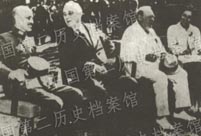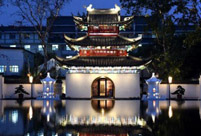 YOG kicks off in Nanjing
YOG kicks off in Nanjing
 Colorful life at Youth Olympic Village of Nanjing 2014 YOG
Colorful life at Youth Olympic Village of Nanjing 2014 YOG
 Royal Taoist temple to open to public
Royal Taoist temple to open to public
 Female soldiers at quake-hit area
Female soldiers at quake-hit area
 Shocking photos of cruel battles in Ukraine
Shocking photos of cruel battles in Ukraine
 Amphibious armored vehicle unit conducts open sea drill
Amphibious armored vehicle unit conducts open sea drill
 Water relay in Henan
Water relay in Henan
 Ethnic culture feasts eyes of travelers
Ethnic culture feasts eyes of travelers
 80 security dogs assembled in Nanjing police dog training base
80 security dogs assembled in Nanjing police dog training base
 Graffiti artists paint on street walls in Xinjiang
Graffiti artists paint on street walls in Xinjiang
Lin Min/China Daily
People come from all corners of the globe to study kung fu, but has the martial art been subverted by big business?
In the ancient mountain fastness of Shaolin Temple, behind the closed doors of a Buddhist sanctum, Abbot Shi Yongxin holdscourt from a lacquered wooden chair carved with dragons.
At his left hand, a trio of warrior monks stands attentively, 1,500 years worth of secret skills and kung fu technique trained into their loose limbs.
There is something of the snake and tiger in their poise and posture, of the crane and the monkey in the way they move.
Amid the trappings of the past in the ornate receiving room, the abbot and his followers seem like throwbacks to China's age of legend, remnants of a bygone era.
The spell is broken by an electronic jingle.
Shi, the 30th spiritual leader of the ancient order, pulls a smartphone out of his robes. He flips it open briefly to scan the screen, grunts and quickly makes the handset disappear again.
The 21st century has come to the famed temple at the heart of Chinese kung fu, bringing with it a new wave of foreign interest from an unlikely quarter, and a growing debate domestically about what this means for the culturally iconic Chan Buddhist institution.
"We pursue a peaceful and simple life," Shi says. "Our ultimate goal is to achieve the enlightenment of Buddha and to help others achieve enlightenment."
But enlightenment isn't always free at Shaolin Temple, not that this matters to a new breed of acolyte prepared to pay for the kung fu wisdom the order offers.
They are CEOs of multimillion-dollar companies, foreign businesspeople from many fields, and motivated professionals willing to fork out about $800 a month to learn and live at Shaolin.
While this phenomenon is part of a business model that is helping secure Shaolin's future, some believe it is also part of a malaise that jeopardizes its ties to the past.
Every day, thousands of tourists throng the temple grounds, once a quiet retreat for 13 famous warrior monks who, legend has it, took down a despotic warlord and his army during the Tang Dynasty (AD 618-907).
In their time, much of the mystery surrounding Shaolin pertained to the arcane, the closely guarded mental and physical abilities that approach the mystical in the telling.
These days the temple is still cloaked in secrecy, but that relates largely to a veil of corporate confidentiality maintained by a separate business entity.
 |
 Eye-catching guides at the opening ceremony of YOG in Nanjing
Eye-catching guides at the opening ceremony of YOG in Nanjing A female missile launch company of PLA
A female missile launch company of PLA China, the U.S., Britain and the Soviet Union call for Japan's unconditional surrender
China, the U.S., Britain and the Soviet Union call for Japan's unconditional surrender Beautiful night scenery of Nanjing
Beautiful night scenery of Nanjing Passenger transport starts on Tibet's new railway
Passenger transport starts on Tibet's new railway Story of outstanding Beijing swat sniper
Story of outstanding Beijing swat sniper Beautiful policewoman in an anti-terrorism SWAT team
Beautiful policewoman in an anti-terrorism SWAT team Cute photos of little Taoist nuns and monks go viral online
Cute photos of little Taoist nuns and monks go viral online Photo story: How a baby panda grows up
Photo story: How a baby panda grows up Star-leveled nursing home in a small county
Star-leveled nursing home in a small county Evidence of monstrous crime of Japanese invaders
Evidence of monstrous crime of Japanese invaders Foreign models compete with Chinese in Cheongsam show
Foreign models compete with Chinese in Cheongsam show The beautiful pictures of ancient Chinese architecture
The beautiful pictures of ancient Chinese architecture The Muslims involved in relief work
The Muslims involved in relief workDay|Week|Month